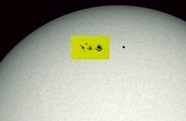![]()
| CAUTION! OBSERVING A TRANSIT IS DANGEROUS AND MAY CAUSE IRREVERSIBLE EYE DAMAGE, UP TO BLINDNESS! Observing a transit necessitates the use of the DEDICATED SAFE TECHNIQUES recommended for the observation of a solar eclipse! |
On November 11th, 2019, Mercury will be transiting the Sun. That astronomical event is a rare one as such occurrences are seen 13 times a century only; next Mercury transits for example, will only occur by 2032 then 2039. Don't miss that show when available for your location! A transit, in astronomy, is when an inferior planet, like Venus or Mercury -a planet, that is, which is located between the Earth and the Sun- is seen, in perspective, transiting against the background of the Sun, as seen from the Earth. For a transit to occur, the inferior planet must be at a inferior conjunction and crossing the line of nodes. A Mercury transit further may occur either when the planet is at its perihelion -- the closest Sun, which occurs in November and is the case for that transit -- or a aphelion -- the farthest, in May. Mercury thus is displayed with a apparent diameter of 10", or 12", respectively. check more about transits of inferior planets theoretically with our Venus and Mercury Transits tutorial
A transit is a fine show, giving a sense of the scales in the solar system as transits, on a other hand, generally, now serve to test techniques which are useful to detect exoplanets. Observing a transit consists into checking the entrance of the planet unto the solar disk, the transit's greatest -when the planet reaches to its closest the solar disk's center, and, eventually, the exit of the planet from the disk. The total duration of that transit is of about 5 hour and 30 minutes as that 2019 transit is a remarkable one in terms of the transit's greatest, with Mercury at 75.9" away from the solar disk's center only! That means that Mercury will transit the Sun about dead in its middle! A further reason not to miss the transit should you live where the transit is available, even partially, and the weather favourable. The November 11th, 2019 Mercury transit will be seen in its entirety from Labrador, Canada down to the whole of South America. Easternmost USA, a part of Central America, and the westernmost areas of West Africa are concerned too. Like what is well known to amateur astronomers about Sun's and Moon's eclipses, areas either side of there will have the transit encours by sunrise, or the transit interrupted by sunset. Most of continental USA, most of Mexico, a large part of the Pacific ocean, and New Zealand will fall in the first category, as most of Europe, Iceland, western Russia, the Middle East, or most of Africa will in the second. Like also the case for eclipses, some areas unluckily will not see the transit: Siberia, Russia in its whole and thence to India, Southeast Asia, Australia or Japan, and the westernmost Pacific ocean and Alaska are in that case. check more about transits of inferior planets in terms of observation with our Venus and Mercury Transits tutorial. The following illustration is showing how Mercury is looking like in front of the Sun during a November transit, when Mercury is displaying a apparent diameter of10". It will help for your telescope and photography gear's choice, with Mercury in 2017 at 2 arcminutes larger! Picture of a sunspots area is also given
 | How a November transit at 10" is looking like, which will help for your telescope and photography gear's choice! Picture of a sunspots area is also given site 'Amateur Astronomy' |
| transit duration: | 05h28m47s |
| Mercury apparent diameter: | 10" |
| contact I: | 12:35:27 UT |
| contact II: | 12:37:08 UT |
| greatest (or "minimum separation"; instant when Mercury passes closest to Sun's center) | 75.9 arcseconds |
| greatest time: | 15:19:48 UT |
| contact III: | 18:02:33 UT |
| contact IV: | 18:04:14 UT |
click to a chart for the world visibility of the November 11th, 2017 Mercury transit. click to a chart for the path of Mercury across the Sun during the November 11th, 2017 Mercury transit. ticks from 15mn into 15mn with hours in UT. The 'position angle' is the direction of Mercury with respect to the center of the Sun's disk as measured counterclockwise from the celestial north point on the Sun. charts courtesy EclipseWise.com
for more about that transit, you may also see at EclipseWise.com
Website Manager: G. Guichard, site 'Amateur Astronomy,' http://stars5.6te.net. Page Editor: G. Guichard. last edited: 1/1/2019. contact us at ggwebsites@outlook.com